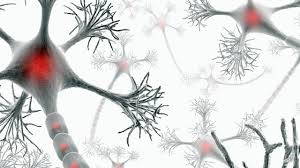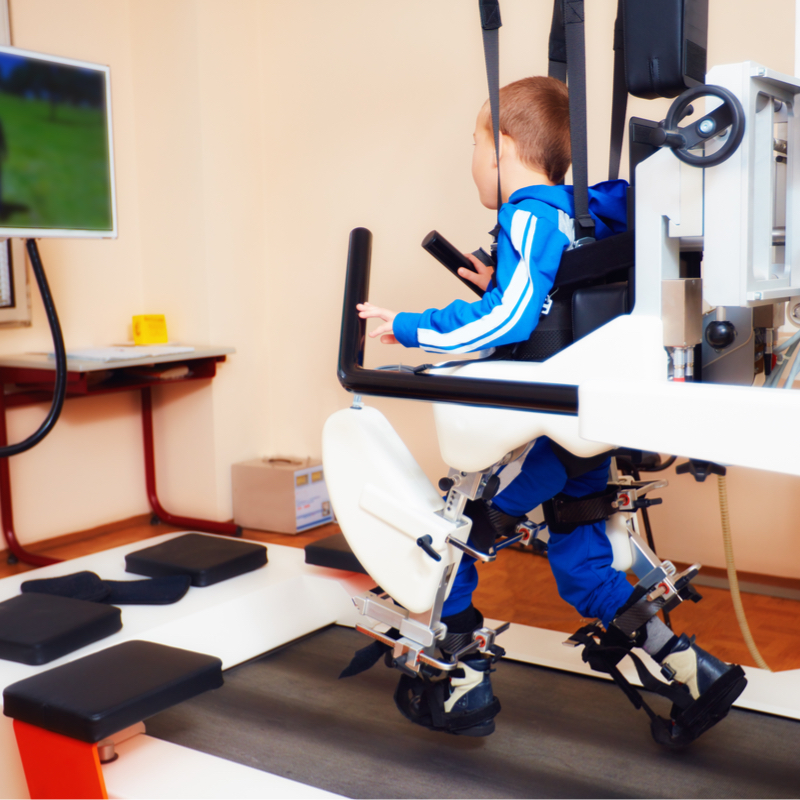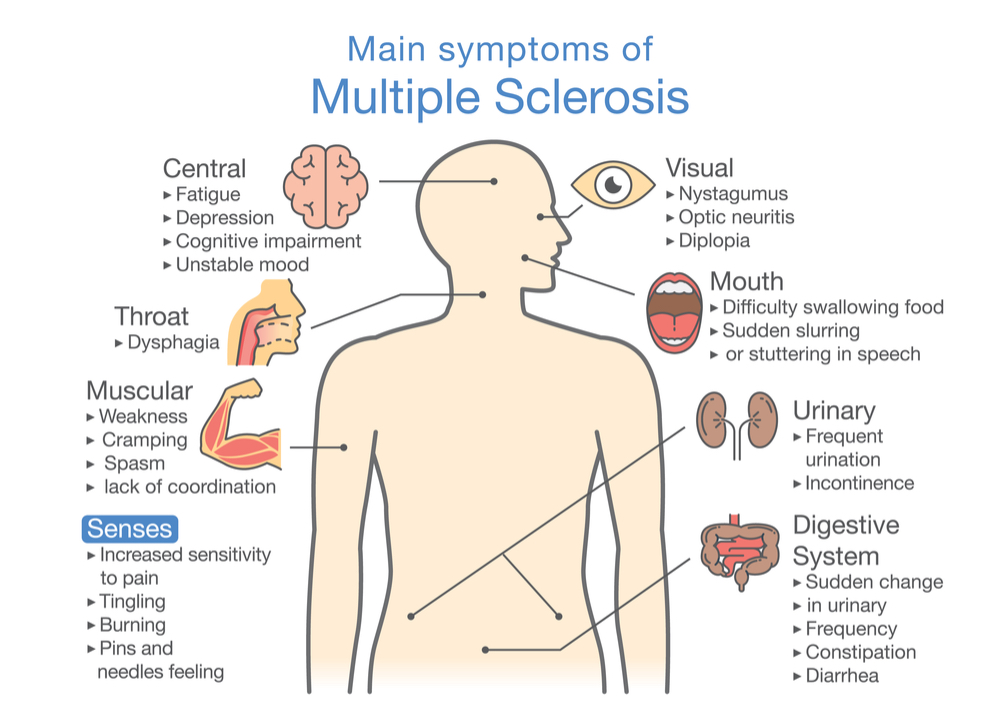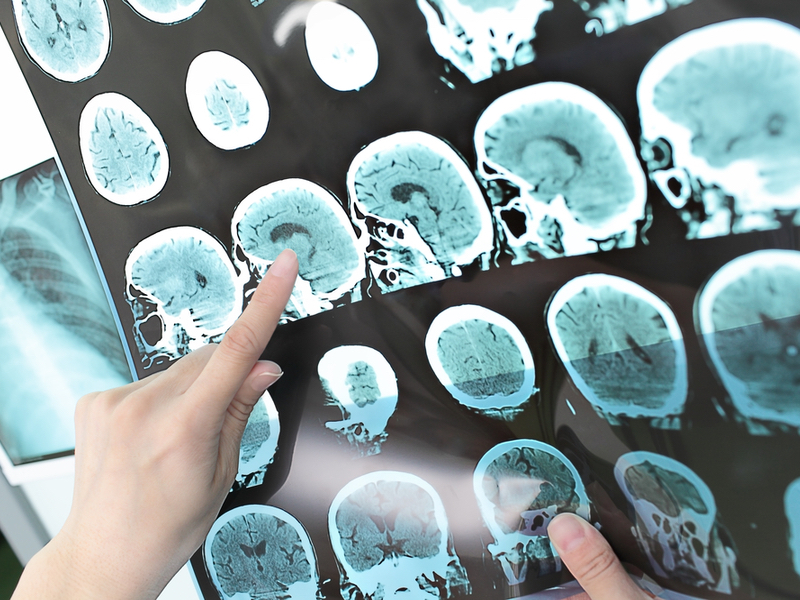Physical Therapy Treatments for Multiple Sclerosis

Original Post Date: November 3rd, 2015
Blog Post Updated: March 12th, 2018
The central nervous system has many functions throughout the body. Comprised of the brain, spinal cord and optic nerves, this system can have quite an impact throughout the body. Not only does it control important mental processes, such as the sensation of pain, but it also controls movement. Multiple sclerosis is a chronic inflammatory disease that affects the functioning of the central nervous system. In this post, we will discuss multiple sclerosis symptoms and causes, and how patients can overcome it through physical therapy treatments.
3 Physical Therapy Exercises for MS
Aside from medications provided by your neurologist, physical therapy can also help. Physical therapy can help reduce immobility and functional limitations. Through a specific therapeutic exercise program we can help you improve or maintain your strength, flexibility, aerobic capacity, balance, and gait issues. The staff at Farmingdale Physical Therapy West will help MS patients to find a beneficial treatment.
1. General Exercises
Exercise is important in aiding in the managing the symptoms of multiple sclerosis. Studies show that exercise leads to improved strength, better cardiovascular fitness, improved digestive system, and less fatigue. It also improves cognitive function, and enhances one’s mood.
A practical application of exercise for patients with MS includes:
- Resistance training: 3 sets of 8-15 repetitions
- Endurance training: 10-40 minutes
- Stretching and balance exercises
2. Aquatic Exercises
Aquatic exercise makes the body feel lighter. This improves the quality of the exercise. It also decreases the severity of fatigue associated with MS.

3. AlterG Anti-Gravity Treadmill
This unique equipment is well-suited for MS patients. The Alter G Treadmill allows the patient to feel as if they weigh as little as 20% of their actual body weight. This goes as high as 100% their body weight. This treadmill allows for typical forward motion at varying speeds, but can also be set in backwards motion. Patient’s can also turn to their sides to work on lateral musculature of their bodies. The Alter G Treadmill is safe environment to perform gait training and strengthening programs for patients with MS. Fall risk is reduced as the patient is supported by the pressure chamber.
What is Multiple Sclerosis?
Multiple sclerosis is a degenerative disease that effects the nerves of the central nervous system. Nerves found throughout our body have a protective tissue over them called the myelin sheath. People diagnosed with MS have an immune system that attacks the protective tissue which leads to lost or poor communication between the brain and the rest of the body. When the myelin sheath is destroyed, the message from a nerve to the brain is “distorted”. With the loss of the myelin MS patients can lose the ability to walk independently and have permanent nerve damage.
What Causes Multiple Sclerosis?
Like other autoimmune diseases, there is no clear answer to the cause of multiple sclerosis. Many experts believe that it is affected by genetic and family history, but this is not certain. However, other environmental factors are also at play.
- Gender: Women are twice as likely to be diagnosed with MS as men.
- Age: Most MS patients are between 15 and 60 years old.
- Family history: People with family members who suffer from MS are more likely to be diagnosed.
- Infections: Certain viruses, such as Epstein-Barr, are linked ot MS.
- Race: Caucasian people are most likely to have MS.
- Smoking: Smoking leads to a higher risk for MS.
- Existing auto-immune disease: People with thyroid diseases, type 1 diabetes and IBD are more likely to have MS.
What are the Symptoms of Multiple Sclerosis?
Initial symptoms of multiple sclerosis depend on the location, size and number of lesions. MS symptoms occur when the immune system causes the central nervous system to become inflamed. The symptoms that result from this inflammation may take weeks or months to resolve. Other symptoms may be permanent. At Farmingdale Physical Therapy West, we can provide treatments to help patients minimize these symptoms.
Based on a patient’s individual condition, they may experience one (or many) of these symptoms, with varying levels of intensity.
14 Common Symptoms of MS
- Muscle weakness
- Fatigue
- Sensitivity to heat
- Sensory disturbances (loss of vision, tingling/prickling feeling)
- Motor Disturbances
- Paralysis
- Loss of movement capability, including gait disorders
- Loss of balance
- Bowel/bladder dysfunction
- Oromotor disturbance
- Depression/anxiety
- Short term memory loss
- Difficulty speaking or swallowing
- Sexual dysfunction

What is a MS Relapse?
Despite extended periods without any symptoms, multiple sclerosis patients can experience relapses. Relapses occur when symptoms “flare up”, or return with greater intensity than before. Relapses can last anywhere from 24 hours to several weeks. These symptoms may be entirely new, or an existing symptom that grows worse. Sometimes, relapses occur randomly, but relapses may also be triggered by infections, trauma, pregnancy and stress. Specialists at Farmingdale Physical Therapy West can help identify and stop these relapses.
The period following this relapse is called remission.
Is There a Cure for MS?
More than 2.3 million people are affected with MS world-wide. Though there is no cure as of yet for MS, scientific breakthroughs are occurring every year. There is still a lot unknown about the disease; such as who becomes diagnosed with it, how to diagnose it early and how to cure it. However, as more information is discovered about the disease the better able doctors are now able to treat it. The average life span for a person with MS is only 7 years less than the “average” person.
Additionally, with the use of physical therapy and medicine, the disease can be controlled. A patient may have less episodes and go into periods of remission where no new symptoms are expressed. Physical therapy can help to regain and work on balance, strength, aerobic activity and stretching. When a patient comes to physical therapy their strengths and weaknesses are assessed and the therapist will make an individualized plan for the patient.
For more information about multiple sclerosis please visit https://www.nationalmssociety.org/
Multiple Sclerosis: Diagnosis
Multiple Sclerosis can be challenging to diagnose. Early symptoms may not be specific enough to conclude a case of MS. Additionally, there is no single test available to prove or rule out MS. So, MS is a clinical diagnosis.

Magnetic resonance imaging (MRI) is a great help in reaching a definitive diagnosis. MRI imaging may provide evidence of lesions and can be used for comparison to determine changes in disease. Combining MRI and clinical symptoms is the best way to make a definitive diagnosis.
The diagnostic clinical criteria includes:
- Two or more incidents of symptoms (attacks).The attacks must last longer than 24 hours, with 30 days between onset and recovery.
- Objective clinical evidence of two or more lesions in two different areas.
Multiple Sclerosis: Treatment
Medical doctors provide the primary treatment for multiple sclerosis patients.
Generally, acute attacks are treated with IV steroids and an oral taper. They may also provide therapy to slow the disease’s progression and decrease exacerbations. Certain medications may address gait issues, chronic fatigue and muscle spasms. At Farmingdale Physical Therapy West, our staff is experienced in providing specialized treatments for optimal recovery.
Some MS patients may need to alter their lifestyle to best treat MS. The following lifestyle choices can help patients to overcome the disease, or minimize symptoms.
Lifestyle Changes to Treat MS:
- Regular exercise
- Healthy diet
- Not smoking
- Preventative care
- Managing other health issues
Multiple Sclerosis: Classifications
The way that MS impacts one’s body changes depending on individual conditions. There are no biological markers distinguishing the various types of MS. These classifications are based on descriptions of the nature, severity, and frequency of the symptoms. At Farmingdale Physical Therapy West, we take this classification into account when developing a treatment plan.
- Relapsing Remitting: About 80% of MS patients fall into this category. It is characterized by a pattern of relapses (flare up of symptoms) followed by periods of complete remission.
- Secondary Progressive: Begins as relapsing remitting, but later there is a shift in the disease. Later the relapses tend to be less distinct, but deficits begin to accumulate. It is here that the disease appears to become less inflammatory, and more neurodegenerative, with increasing damage to the axons and cell death.
- Primary Progressive: Usually diagnosed later in life, this affects 10-15% of the MS population. From the time of onset, symptoms steadily worsen, with no detectable relapses. There are no clear cut flare ups, but gradual increases in deficits over time. Nerve damage is more severe than inflammation, which causes poor balance, difficulty walking and stiffness.
- Progressive Relapsing: Usually affects about 5% of the MS population. It takes a progressive course upon which relapses are overlapped. There may not be recovery after these flare ups.
Long Island Physical Therapy
At Farmingdale Physical Therapy West, we can help patients to overcome multiple sclerosis symptoms. With an individualized treatment plan based on particular symptoms, our team of physical therapists will help each patient to

